No CrossRef data available.
Article contents
Assignment of values for a set of in-house developed verification masses using an inter laboratory comparison approach
Published online by Cambridge University Press: 29 June 2011
Abstract
Traceable measurements are a mandate for the reliability of test results. Although periodic calibration activities ensure traceability, in between verifications are essential to maintain the consistency of results. In analytical laboratories, electronic balances are widely used for quantity estimations. Owing to the inherent instability problems associated with semiconductor strain gauges and performance degradation on aging, they need to be regularly controlled using verification mass. But traceable and calibrated masses are expensive for routine use in laboratories. A mass set is designed, prepared in-house and mass values with uncertainty are assigned to undergo such verification. Steps employed to assign the mass values based on the principle of inter laboratory comparison (ILC) are reported. Reference value and corresponding uncertainty estimations are determined by performing an ILC in five different laboratories. The measurement results with uncertainty from each laboratory were received for individual masses. These results were analyzed for consistency and the values along with the weighted uncertainties were assigned.
- Type
- Research Article
- Information
- Copyright
- © EDP Sciences 2011


